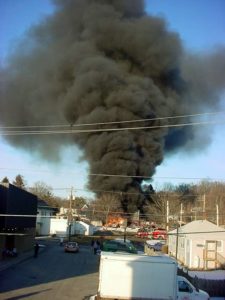Emergency Management is a vital function involving all departmental levels of local government. Each department takes part in efforts to prepare for, respond to, mitigate, and recover from all types of dangerous or hazardous situations. During times when no emergencies exist, some of the duties handled by the Emergency Management Coordinator (EMC) include the identification and analysis of the effects of hazards which might pose a threat to the Town of Newton and to attend training courses to keep skills and knowledge current.
Newton Office of Emergency Management
Meet Newton’s Emergency Management Staff
What is Emergency Management?

Able Oil Explosion 2003
Emergency management was institutionalized in 1979 with the creation of the Federal Emergency Management Agency (FEMA). Five Federal agencies that dealt with many types of emergencies consolidated to form FEMA. Since that time, many State and local organizations have changed the names of their organizations to include the words: emergency management.
The name change indicates a change in orientation from specialized preparedness for single or narrowly defined categories of hazards toward an all-hazards approach that includes potential threats to life and property through environmental and technological hazards, and domestic and foreign attacks. This change reflects not a reduction in security, but an increased emphasis on making the nation’s emergency management capability responsive to any major emergency.
The Four Phases of Emergency Management
Since World War II emergency management has focused primarily on preparedness. Often this involved preparing for enemy attack. Community preparedness for all disasters requires identifying resources and expertise in advance, and planning how these can be used in a disaster. However, preparedness is only one phase of emergency management. Current thinking defines four phases of emergency management: mitigation, preparedness, response, and recovery.
Click the toggles below to learn more about each phase of emergency management.
Mitigation
Preventing future emergencies or minimizing their effects
- Includes any activities that prevent an emergency, reduce the chance of an emergency happening, or reduce the damaging effects of unavoidable emergencies.
- Buying flood and fire insurance for your home is a mitigation activity.
- Mitigation activities take place before and after emergencies.
According to the January 2019 National Institute of Building Sciences Natural Hazard Mitigation Saves: 2018 Interim Report, federal mitigation grants save $6 for every $1 spent!.
The Town of Newton is a participant in the Sussex County, New Jersey All-Hazards Pre-Disaster Mitigation Planning Project along with other stakeholders from Sussex County and surrounding areas. Stakeholders work together to draft a countywide plan with specific annexes for each jurisdiction. Required approvals are sought from FEMA before each participating municipality adopts and implements the plan.
A Hazard Mitigation Plan is a well-organized and well-documented evaluation of the hazards that a jurisdiction is susceptible to, and the extent to which these events will occur. Hazard Mitigation Plans identify an area’s vulnerability to the effects of the natural and manmade hazards, as well as the goals, objectives, and actions required for minimizing future loss of life, injury, property damage, and economic disruption as a result of hazard events.
Details regarding the plan and the Sussex County, New Jersey All-Hazards Pre-Disaster Mitigation Planning Project area available online for public review, input, and participation.
Preparedness
Preparing to handle an emergency
- Includes plans or preparations made to save lives and to help response and rescue operations.
- Evacuation plans and stocking food and water are both examples of preparedness.
- Preparedness activities take place before an emergency occurs.
Response
Responding safely to an emergency
- Includes actions taken to save lives and prevent further property damage in an emergency situation. Response is putting your preparedness plans into action.
- Seeking shelter from a tornado or turning off gas valves in an earthquake are both response activities.
- Response activities take place during an emergency.
Recovery
Recovering from an emergency
- Includes actions taken to return to a normal or an even safer situation following an emergency.
- Recovery includes getting financial assistance to help pay for the repairs.
- Recovery activities take place after an emergency.
Homeland Security Alerts
Latest Facebook Posts
1 week ago
2 weeks ago
2 weeks ago




